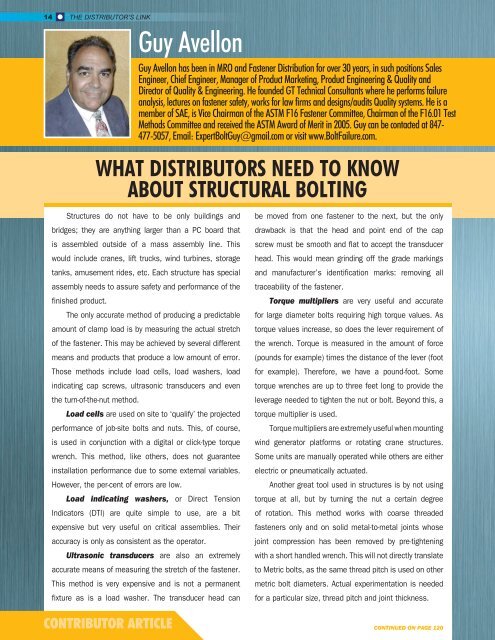FALL 2023
Distributor's Link Magazine Fall 2023 / Vol 46 No 4
Distributor's Link Magazine Fall 2023 / Vol 46 No 4
You also want an ePaper? Increase the reach of your titles
YUMPU automatically turns print PDFs into web optimized ePapers that Google loves.
14<br />
THE DISTRIBUTOR’S LINK<br />
Guy Avellon<br />
Guy Avellon has been in MRO and Fastener Distribution for over 30 years, in such positions Sales<br />
Engineer, Chief Engineer, Manager of Product Marketing, Product Engineering & Quality and<br />
Director of Quality & Engineering. He founded GT Technical Consultants where he performs failure<br />
analysis, lectures on fastener safety, works for law firms and designs/audits Quality systems. He is a<br />
member of SAE, is Vice Chairman of the ASTM F16 Fastener Committee, Chairman of the F16.01 Test<br />
Methods Committee and received the ASTM Award of Merit in 2005. Guy can be contacted at 847-<br />
477-5057, Email: ExpertBoltGuy@gmail.com or visit www.BoltFailure.com.<br />
WHAT DISTRIBUTORS NEED TO KNOW<br />
ABOUT STRUCTURAL BOLTING<br />
Structures do not have to be only buildings and<br />
bridges; they are anything larger than a PC board that<br />
is assembled outside of a mass assembly line. This<br />
would include cranes, lift trucks, wind turbines, storage<br />
tanks, amusement rides, etc. Each structure has special<br />
assembly needs to assure safety and performance of the<br />
finished product.<br />
The only accurate method of producing a predictable<br />
amount of clamp load is by measuring the actual stretch<br />
of the fastener. This may be achieved by several different<br />
means and products that produce a low amount of error.<br />
Those methods include load cells, load washers, load<br />
indicating cap screws, ultrasonic transducers and even<br />
the turn-of-the-nut method.<br />
Load cells are used on site to ‘qualify’ the projected<br />
performance of job-site bolts and nuts. This, of course,<br />
is used in conjunction with a digital or click-type torque<br />
wrench. This method, like others, does not guarantee<br />
installation performance due to some external variables.<br />
However, the per-cent of errors are low.<br />
Load indicating washers, or Direct Tension<br />
Indicators (DTI) are quite simple to use, are a bit<br />
expensive but very useful on critical assemblies. Their<br />
accuracy is only as consistent as the operator.<br />
Ultrasonic transducers are also an extremely<br />
accurate means of measuring the stretch of the fastener.<br />
This method is very expensive and is not a permanent<br />
fixture as is a load washer. The transducer head can<br />
CONTRIBUTOR ARTICLE<br />
be moved from one fastener to the next, but the only<br />
drawback is that the head and point end of the cap<br />
screw must be smooth and flat to accept the transducer<br />
head. This would mean grinding off the grade markings<br />
and manufacturer’s identification marks: removing all<br />
traceability of the fastener.<br />
Torque multipliers are very useful and accurate<br />
for large diameter bolts requiring high torque values. As<br />
torque values increase, so does the lever requirement of<br />
the wrench. Torque is measured in the amount of force<br />
(pounds for example) times the distance of the lever (foot<br />
for example). Therefore, we have a pound-foot. Some<br />
torque wrenches are up to three feet long to provide the<br />
leverage needed to tighten the nut or bolt. Beyond this, a<br />
torque multiplier is used.<br />
Torque multipliers are extremely useful when mounting<br />
wind generator platforms or rotating crane structures.<br />
Some units are manually operated while others are either<br />
electric or pneumatically actuated.<br />
Another great tool used in structures is by not using<br />
torque at all, but by turning the nut a certain degree<br />
of rotation. This method works with coarse threaded<br />
fasteners only and on solid metal-to-metal joints whose<br />
joint compression has been removed by pre-tightening<br />
with a short handled wrench. This will not directly translate<br />
to Metric bolts, as the same thread pitch is used on other<br />
metric bolt diameters. Actual experimentation is needed<br />
for a particular size, thread pitch and joint thickness.<br />
CONTINUED ON PAGE 120
















